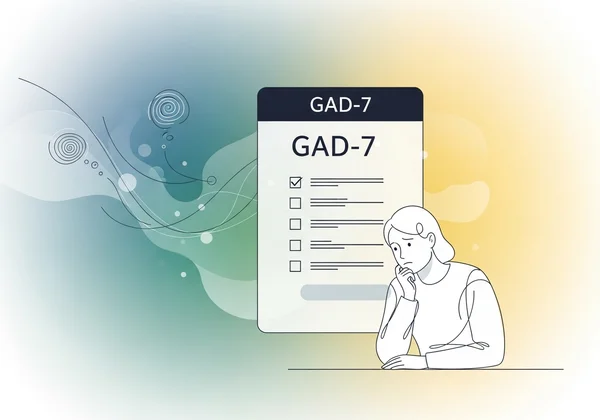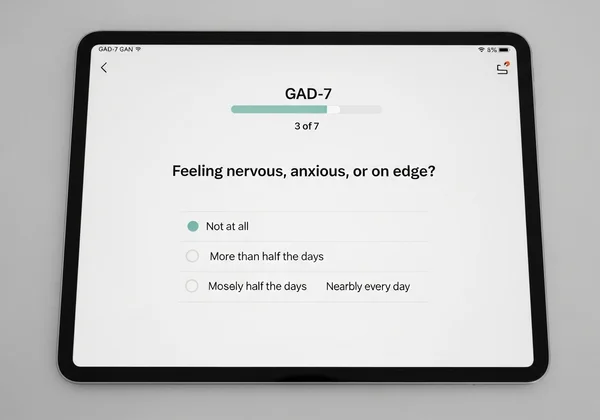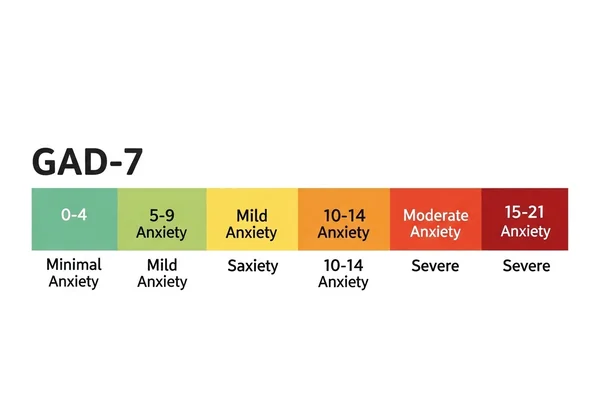GAD-7 Test in Spanish: Your Online Anxiety Screening
Have you been feeling overwhelmed by constant worry, nervousness, or an inability to relax? Understanding these feelings is the first step toward managing them, and a reliable tool can make all the difference. What is GAD-7 and how can it help you understand your anxiety in your native language? The GAD-7 test in Spanish is a quick, confidential, and scientifically validated way to measure your anxiety symptoms. This guide will walk you through what the GAD-7 is, how to interpret your score, and what your next steps can be on your path to mental well-being. If you're ready to gain clarity, you can take our free GAD-7 test today.
What is the GAD-7? The Generalized Anxiety Scale
The GAD-7, or Generalized Anxiety Disorder 7-item scale, is a self-assessment tool used by healthcare professionals and individuals worldwide to screen for and measure the severity of generalized anxiety. It's not a scary, complex medical procedure; it's a straightforward questionnaire designed to be a starting point for a conversation about your mental health. It gives you a simple, numerical score that provides a snapshot of how anxiety symptoms have affected you over the past two weeks.

Why Is It Important to Assess Anxiety?
Acknowledging and measuring anxiety is a powerful act of self-care. Many people dismiss persistent worry or physical tension as just "stress," but these can be signs of an underlying anxiety condition. Using a tool like the GAD-7 helps objectify your feelings, moving them from a vague sense of unease to a measurable concept. This understanding empowers you to communicate more effectively with loved ones or medical professionals and helps you recognize when it's time to seek support. Taking a moment for a self-assessment tool is a proactive step toward prioritizing your mental health.
The Origin and Validation of the GAD-7
To trust a tool, you need to know it's reliable. The GAD-7 was developed by Drs. Robert L. Spitzer, Kurt Kroenke, Janet B.W. Williams, and Bernd Löwe in 2006. It was created as a brief, effective instrument based on the diagnostic criteria for Generalized Anxiety Disorder (GAD) from the DSM-IV. Numerous studies have confirmed that it is a validated scale for screening for GAD and other common anxiety disorders. Its brevity and accuracy have made it a go-to resource in both clinical settings and for personal use, providing trustworthy insights for people across the globe.
How the Online GAD-7 Test Works
Taking the GAD-7 test on our platform is designed to be simple, fast, and stress-free. The process on our confidential GAD-7 platform is straightforward: you'll answer seven questions about how often you've been bothered by various symptoms over the last two weeks. The beauty of an online format is the immediate feedback. Once you complete the questionnaire, your score is calculated instantly, providing you with an initial interpretation right away. This immediate insight is a core part of our mission to make mental health awareness accessible to everyone.

The 7 Key Symptoms Evaluated by the GAD-7
The GAD-7 focuses on the most common emotional and physical anxiety symptoms. The seven questions ask you to rate the frequency of experiencing the following:
- Feeling nervous, anxious, or on edge.
- Not being able to stop or control worrying.
- Worrying too much about different things.
- Trouble relaxing.
- Being so restless that it is hard to sit still.
- Becoming easily annoyed or irritable.
- Feeling afraid as if something awful might happen.
Together, these questions paint a full picture of your experience with anxiety, looking beyond just "worry" to include restlessness, irritability, and fear.
Your Privacy and Confidentiality
We understand that seeking information about your mental health is a private matter. Your privacy is our top priority. The confidential GAD-7 test you take is completely anonymous. We do not require you to create an account or provide any personal identification to get your score. This commitment to confidentiality ensures you can feel safe and secure as you take this important step for your emotional well-being. Our goal is to provide a trusted space where you can explore your feelings without fear of judgment or exposure.
GAD-7 Scoring and Interpretation in Spanish
Once you complete the test, you'll receive a score ranging from 0 to 21. Understanding this score is the key to making the GAD-7 a useful tool for your self-reflection. Our platform provides the official GAD-7 scoring interpretation in clear, accessible language, available in Spanish and over 15 other languages. This ensures you can understand your results without confusion or the need for a translator, empowering you with direct insight into your current state of anxiety.

Scoring Ranges: From Mild to Severe Anxiety
The GAD-7 score is typically broken down into four categories, which provide a general guideline for the level of anxiety symptoms. Here is the standard breakdown and the score meaning:
- 0-4: Minimal Anxiety. Your score suggests you are likely experiencing minimal to no anxiety symptoms.
- 5-9: Mild Anxiety. Your score indicates the presence of mild anxiety symptoms. It may be helpful to monitor your symptoms.
- 10-14: Moderate Anxiety. Your score suggests a moderate level of anxiety. At this level, it's highly recommended to consider speaking with a doctor or mental health professional.
- 15-21: Severe Anxiety. Your score points to severe anxiety symptoms. Seeking professional evaluation and treatment is strongly advised.
It's crucial to remember these are guidelines, not diagnoses. How you feel is just as important as the number.
What Your GAD-7 Score Means for You
Your score is a personal tool for insight. A low score might bring relief, while a higher score might be a call to action. But no matter the number, it does not define you. Instead, view it as information—a starting point. For a deeper understanding, our platform offers a unique AI-powered report. This optional feature analyzes your answers to provide personalized insights into your strengths, challenges, and actionable steps, turning your GAD-7 score from a number into a personalized guide for your mental health journey.
Next Steps After Your GAD-7 Score
Receiving your GAD-7 score is the beginning, not the end, of the process. The results are a catalyst for informed action. Whether your score is low, moderate, or high, there are always positive steps you can take to support your mental health. This section is dedicated to guiding you on what to do next, ensuring you feel supported and clear on your options for moving forward.
When to Consider Seeking Professional Help
The GAD-7 is a screening tool, not a diagnostic one. If your score is in the moderate to severe range (10 or above), or if your symptoms are causing you significant distress regardless of your score, it is a strong signal to seek professional help. A doctor, therapist, or counselor can provide a formal diagnosis and work with you to create a treatment plan. You can bring your GAD-7 results to your appointment to start the conversation—it’s an excellent way to clearly communicate what you’ve been experiencing.

Initial Strategies for Managing Anxiety
While professional support is key for moderate to severe anxiety, there are also daily coping strategies you can implement to manage symptoms. Simple practices like deep breathing exercises, mindfulness meditation, regular physical activity, and ensuring you get enough sleep can have a significant positive impact. You might also consider reducing caffeine intake and connecting with supportive friends or family. These small, consistent actions can build resilience and improve your overall emotional well-being.
Your Path to Well-Being: The First Step
Understanding your anxiety is a courageous first step on the path to well-being. Tools like the GAD-7, especially when available in your native language like Spanish, break down barriers and empower you with the knowledge to take control of your mental health. Remember, your score is simply a piece of information—a guidepost to help you navigate your journey. It is a sign of strength to seek clarity and support.
Are you ready to take that first step? We invite you to start your GAD-7 assessment on our secure and confidential platform. Gain immediate insights and explore our unique AI-powered reports for personalized guidance.
Preguntas Frecuentes sobre la Prueba GAD-7
Is the GAD-7 test a medical diagnosis?
No, the GAD-7 is a screening tool, not a medical diagnosis. It is highly effective at identifying potential anxiety symptoms, but only a qualified healthcare professional can provide an official diagnosis. Think of it as a helpful conversation starter for you and your doctor.
How accurate is the GAD-7 test?
The GAD-7 is a highly reliable and scientifically validated tool used in clinical practice worldwide. Studies show it has strong accuracy for identifying generalized anxiety disorder and other anxiety conditions. However, its accuracy depends on honest self-reporting.
What is the recommended age range for using the GAD-7?
The GAD-7 was originally validated for use in adults. While it is sometimes used with adolescents (typically 12 and older), its interpretation may require clinical judgment. If you are a minor, it's best to discuss your symptoms with a parent, guardian, or trusted adult who can help you find professional support.
What should I do if my GAD-7 score is high?
A high score (15 or above) suggests severe anxiety symptoms and is a strong indicator that you should seek professional help. We strongly recommend scheduling an appointment with a doctor or mental health professional to discuss your results and explore treatment options. You can take the first step by using our online GAD-7 tool and sharing the results.
How can I start reducing my anxiety today?
You can start with small, manageable steps. Try a 5-minute deep breathing exercise, go for a short walk, or write down your worries in a journal. Reducing caffeine and making time for a relaxing activity you enjoy can also help. For more structured guidance, consider exploring our GAD-7 resource platform.